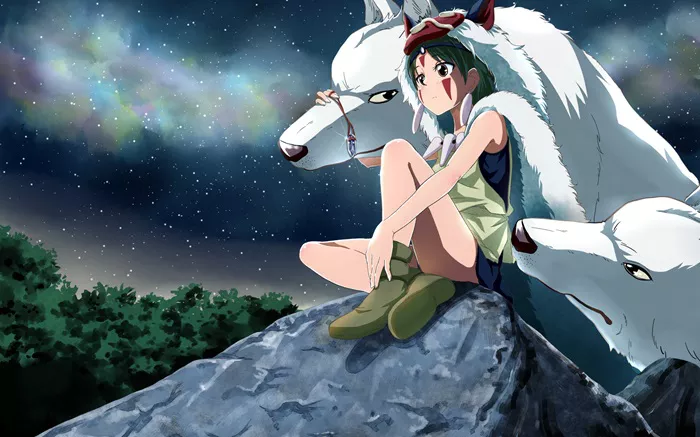Princess Mononoke,” directed by the legendary Hayao Miyazaki and produced by Studio Ghibli, is a film that has captured the hearts of audiences worldwide since its release in 1997. Renowned for its deep narrative, stunning animation, and profound messages, this film is often hailed as a masterpiece in the realm of animated movies. This article explores various aspects of “Princess Mononoke” to determine whether it is worth watching, delving into its themes, characters, visual artistry, cultural impact, and overall significance in the cinematic world.
Princess Mononoke
“Princess Mononoke” is set in the late Muromachi period (approximately 1336 to 1573) of Japan and delves into the conflicts between the supernatural guardians of a forest and the humans who consume its resources. The story follows the journey of Ashitaka, a young prince who seeks to find a cure for a curse placed on him by a demonized boar god. His quest leads him into the heart of the conflict involving humans, gods, and nature.
The Genesis and Production of Princess Mononoke
The film’s production was a monumental task for Studio Ghibli, taking several years to complete. Miyazaki’s inspiration for the film came from his desire to create a narrative that depicted the struggle between ecological preservation and human advancement, a recurring theme in many of his works. The animation process involved groundbreaking techniques that combined traditional hand-drawn animation with computer-generated imagery, setting new standards in the industry.
Narrative Complexity and Themes
“Princess Mononoke” is not just a simple tale of good versus evil; it is a complex exploration of the nuances of environmentalism, industrialization, and humanity.
Environmentalism and Conflict
At its core, the film addresses the impact of human industrial activities on the natural world. Unlike typical environmentalist films that clearly delineate the line between heroes and villains, “Princess Mononoke” presents a balanced view, showing good and bad qualities on both sides of the conflict. This portrayal encourages viewers to think deeply about the moral complexities of human progress versus nature conservation.
The Curse of Hatred
Ashitaka’s curse symbolizes the broader theme of hatred and its destructive impacts. The film explores how hatred, once fostered, can lead to a cycle of suffering and retaliation, a message that resonates with global audiences amidst widespread social and political strife.
The Role of Women
“Princess Mononoke” features strong, independent female characters who defy traditional gender roles. San, the titular Princess Mononoke, is a fierce warrior raised by wolves, whose strength and complexity as a character challenge conventional portrayals of women in animation.
Character Development and Interaction
The characters in “Princess Mononoke” are richly developed, each adding depth and perspective to the story’s themes.
Ashitaka: The Mediator
Ashitaka serves as a mediator who strives to see both sides of the human-nature divide, making him a relatable and compelling protagonist. His journey is one of self-discovery and sacrifice, emblematic of the classic hero’s journey in literature and film.
San and Lady Eboshi: Contrasting Ideals
San and Lady Eboshi are two pivotal characters who represent contrasting views on the human-nature relationship. San sees humans as enemies of the forest while Eboshi views technological progress as a means to improve human lives. Their interactions and development throughout the film highlight the possibilities and challenges of coexistence between humans and nature.
Visual and Artistic Mastery
The animation in “Princess Mononoke” is a visual feast, showcasing Studio Ghibli’s dedication to quality and detail.
Animation Techniques
The blend of hand-drawn cel animation with pioneering uses of CGI creates a lush, immersive world that has stood the test of time. The attention to detail in every frame, from the depiction of the ancient forest landscapes to the intricate designs of the Iron Town, contributes to a rich visual experience.
Symbolism and Imagery
The film uses powerful symbolism and imagery to reinforce its themes. For instance, the kodama (tree spirits) signify the health of the forest, appearing when the forest is thriving and disappearing as it deteriorates.
Cultural Impact and Legacy
Since its release, “Princess Mononoke” has left a lasting impact on the global film industry and on audiences around the world.
Global Reception
Upon release, “Princess Mononoke” became the highest-grossing film in Japan until it was surpassed by “Titanic.” It received widespread acclaim for its ambitious storytelling and its technical achievements, garnering several awards and nominations.
Influence on Animation and Environmental Discourse
The film has influenced a generation of animators and filmmakers and sparked conversations about environmental issues, inspiring viewers to consider more sustainable interactions with the natural world.
Conclusion: Is Princess Mononoke Worth Watching?
“Princess Mononoke” is more than just an animated film; it is a profound narrative that combines spectacular animation with deep, thought-provoking themes. It challenges viewers to reflect on their relationships with nature, technology, and each other. With its enduring relevance, groundbreaking animation, and compelling storytelling, “Princess Mononoke” is undoubtedly worth watching. Whether you are a fan of animation, interested in environmental issues, or simply love well-crafted stories, this film is a must-see that promises an enriching cinematic experience.

